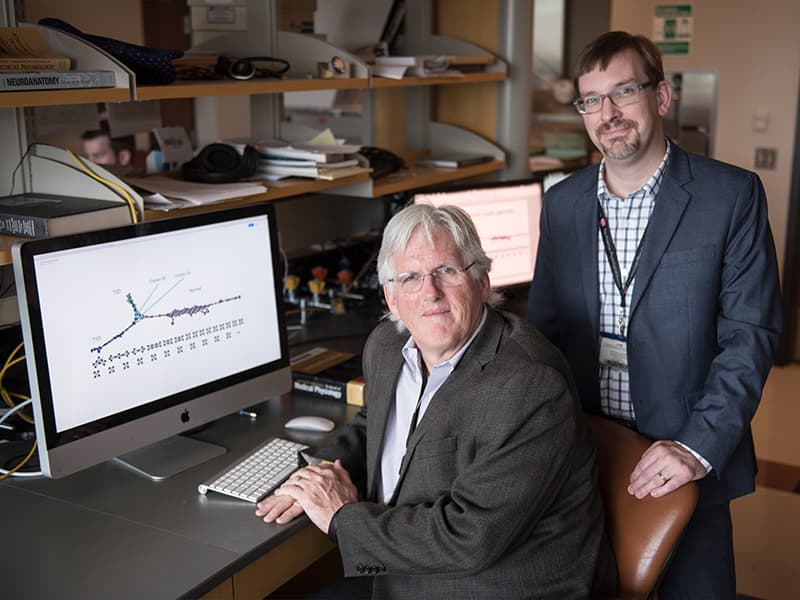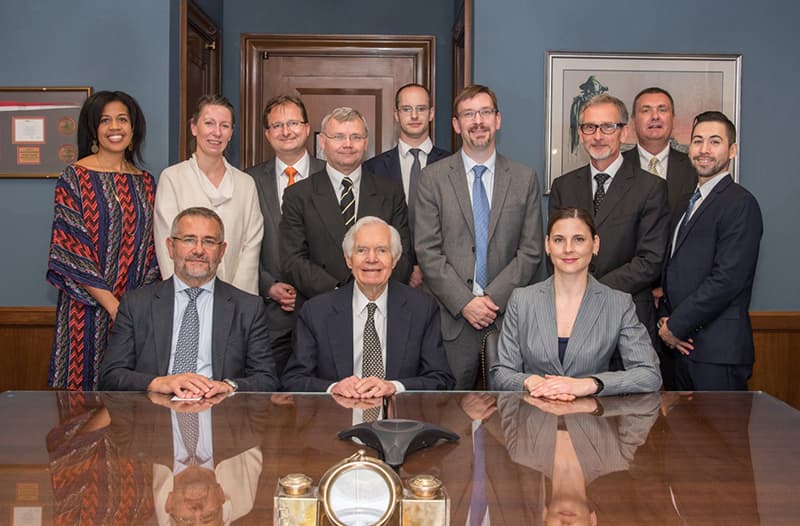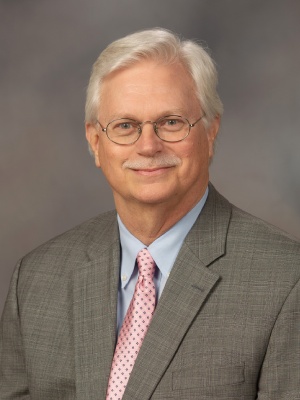Math, medicine converge with HumMod

Dr. Robert Hester’s laboratory has no pipettes or microscopes, no test tubes or cell lines. Instead, there are computers.
Those computers contain people – lungs breathing, hearts beating – or at least the closest replicas one can build with code and equations and variables. Now, those people have another human characteristic: a name of their own.
HumMod, the latest iteration of one of the University of Mississippi Medical Center’s legacy projects, “simulates human physiology under normal and pathological situations,” said Hester, Billy S. Guyton Distinguished Professor of physiology and biophysics. (He's seen at left in the photo above with Drew Pruett.)
In June, HumMod received its registered trademark from the U.S. Patent and Trademark Office. The designation gives HC Simulation, Hester’s company licensed by UMMC to distribute and manage products, legal ownership of the name they’ve used for several years.
“Establishing a brand is an important part of a business plan,” said Dr. William “Drew” Pruett, instructor of physiology and biophysics. “A portion of the proceeds from HumMod will go back to the Department of Physiology and the Office of Research, to fund more research at UMMC.”
HumMod is the product of decades of UMMC research. In the 1960’s, Dr. Arthur Guyton and Dr. Thomas Coleman, former physiology department chair and professor, started hand-drawing an electrical circuit-like model of the cardiovascular system. Advances in biomedical science, computer programming and the efforts of many faculty collaborators led to what Hester calls one of the “best, most complete, mathematical models of human physiology ever created.”
The model now has 10,000 possible variables, representing metabolic, circulatory and endocrine processes, among others. It also allows researchers to factor in common medications, diet, activity and environmental conditions. At the simplest level, HumMod works like an algebraic equation, Hester said. By varying the model human’s characteristics, the slope and intercept, researchers can study physiological responses.

These features make the model a powerful asset for biomedical research and development, and the Food and Drug Administration sees the potential. Through the aid of a Small Business Innovation Research grant, Pruett is validating HumMod for use in medical device trials related to one of its oldest established protocols: hypertension.
The idea is to use HumMod to “streamline clinical trials by using relevant variables from trial participants’ unique physiologies to predict how likely they will be to respond to a given treatment,” Hester said.
Unlike medications, device interventions are difficult to reverse. For example, one experimental hypertension treatment relies on denervation in the kidney. If a participant undergoes the procedure and doesn’t experience a benefit, there’s no way to regrow lost nerves. By pre-screening potential participants, investigators can limit the intervention to those for whom the treatment is most appropriate.
“We are using big data to modernize the clinical trial process,” Pruett said. “These trials are very expensive and can be taxing for participants. Using HumMod to enhance clinical trials would be good for patients and good for companies, making it a win-win for FDA.”
In May, Pruett and a group of industry and nonprofit stakeholders from the United States and Europe met with Senator Thad Cochran to discuss how sophisticated models like HumMod can aid the evaluation of pharmaceuticals and medical devices. One possibility is through in silico, or computer-based, clinical trials. Giving virtual treatments to virtual populations could save time, effort, and enrich in vivo trials, Hester said.

However, no program can perfectly mimic human biology and behavior. While HumMod works well for “global” physiology, like endocrinology or response to exercise, Pruett said, it can’t simulate targeted responses, like localized inflammation from an injury. But as scientists refine our understanding of the human body, HumMod can be refined to include new functions and fit new assumptions.
Dr. Richard Summers, associate vice chancellor for research and HumMod collaborator, said that the model also has great value to precision medicine.

“Precision medicine has generally focused on patient genomics, but [HumMod’s] prediction capacity of the broader integrative dynamics of patient pathophysiology may have more important practical applications in medical management,” Summers said.
HumMod is one of several projects supported by UMMC’s Technology Transfer Office, which aids researchers in obtaining patents, trademarks and other efforts to commercialize their discoveries.
“In this age of rapidly emerging technological advancements, tech transfer efforts by our researchers keep UMMC on the cutting edge of medical innovation,” Summers said.
HumMod and its predecessors have been on that cutting edge for half a century, using math to accelerate medical research.
“We’re working to turn basic science into something that makes a difference for patients,” Pruett said.


